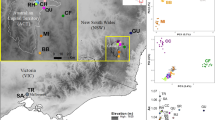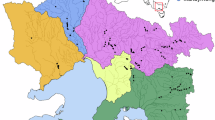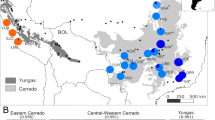Abstract
Allozyme diversity was surveyed at 15 loci across 22 populations of the hydrophilous seagrass Posidonia australis (Hook. f). Substantial genetic variation was detected (HT = 0.311) with a high proportion of this variation partitioned between populations (GST = 0.623). The high value of GST is attributed to large geographical distances between many of the populations and several of the extreme north-western populations having fixed homozygous genotypes. Southwestern populations of P. australis were the most variable and these correlate with the highest species diversity in this genus. Intermediate levels of genetic diversity are observed in P. australis when compared with other hydrophilous angiosperms. Average gene diversity values for hydrophilous taxa surveyed to date indicate lower HT and higher GST values than an average reported for 468 plant taxa. Patterns of genetic variability in different regions of the distribution of P. australis may reflect past evolutionary diversification into novel environments and subsequent dispersal following the rifting of Australia from Antarctica in the early Tertiary.
Similar content being viewed by others
Article PDF
References
Alberte, R S, Suba, G K, Procaccini, G, Zimmerman, R C, and Fain, S R. 1994. Assessment of genetic diversity of seagrass populations using DNA fingerprinting: implications for population stability and management. Proc Natl Acad Sci USA, 91, 1049–1053.
Barrett, S C H, and Shore, J S. 1989. Isozyme variation in colonizing plants. In: Soltis, D. E. and Soltis, P. S. (eds) Isozymes in Plant Biology, pp. 106–126. Dioscor-ides Press, Portland, OR.
Barrett, S C H, Eckert, C G, and Husband, B C. 1993. Evolutionary processes in aquatic plant populations. Aquat Bot, 44, 105–145.
Cambridge, M L, and Kuo, J. 1979. Two new species of seagrass from Australia, Posidonia sinuosa and P. angustifolia (Posidoniaceae). Aquat Bot, 6, 307–328.
Cambridge, M L, and McComb, A J. 1984. The loSS of seagrass in Cockburn Sound, Western Australia. I. The time course and magnitude of seagrass decline in relation to industrial development. Aquat Bot, 21, 229–243.
Cox, P A. 1993. Water-pollinated plants Sci Am, 269(4), 50–56.
Eckert, C G, and Barrett, S C H. 1993. Clonal reproduction and patterns of genotypic diversity in Decodon verticillatus (Lythraceae). Am J Bot, 80, 1175–1182.
Ellstrand, N C, and Roose, M. 1987. Patterns of genotypic diversity in clonal plant species. Am I Bot, 74, 123–131.
Hamrick, J L, and Godt, M J W. 1989. Allozyme diversity in plant species. In: Brown, A. H. D., Clegg, M. T., Kahler, A. L. and Weir, B. S. (eds) Plant Population Genetics, Breeding and Genetic Resources, pp. 43–63. Sinauer Associates, Sunderland, MA.
Kirkman, H. 1985. Community structure in seagrasses in southern Western Australia. Aquat Bot, 21, 363–375.
Kirkman, H, and Kuo, J. 1990. Pattern and process in southern Australian seagrasses. Aquat Bot, 37, 367–382.
Kirkman, H, and Walker, D I. 1989. Regional studies-Western Australian seagrasses. In: Larkum, A. W. D., McComb, A J, and Shepherd, S A. (eds) Biology of Seagrasses: A Treatise on the Biology of Seagrasses with Special Reference to the Australian Region, pp. 157–181. Elsevier, Amsterdam.
Kuo, J. 1982. Notes on the biology of Australian seagrasses. Proc Linn Soc New South Wales, 106, 225–245.
Kuo, J, and Cambridge, M L. 1984. A taxonomic study of the Posidonia ostenfeldii complex (Posidoniaceae) with description of four new Australian seagrasses Aquat Bot, 20, 267–295.
Larkum, A W D, and Den Hartog, C. 1989. Evolution and biogeography of seagrasses. In: Larkum, A. W. D., McComb, A. J. and Shepherd, S. A. (eds) Biology of the Seagrasses: A Treatise on the Biology of Seagrasses with Special Reference to the Australian Region, pp. 112–156. Elsevier, Amsterdam.
Laushman, R H. 1993. Population genetics of hydrophilous angiosperms. Aquat Bot, 44, 147–158.
Les, D H. 1988. Breeding systems, population structure and evolution in hydrophylous angiosperms. Ann Mo Bot Card, 75, 819–835.
Les, D H. 1991. Genetic diversity in the monoecious hydrophile Ceratophyllum (Ceratophyllaceae). Am J Bot, 78, 1070–1082.
Lokker, C, Susko, D, Lovett-Doust, L, and Lovett-Doust, J. 1994. Population genetic structure of Vallis-neria americana, a dioecious clonal macrophyte. Am J Bot, 81, 1004–1012.
McMillan, C. 1981. Morphological variation and isozymes under laboratory conditions in Cymodocea serrulata. Aquat Bot, 10, 356–370.
McMillan, C. 1982. Isozymes in seagrasses. Aquat Bot, 14, 231–243.
McMillan, C. 1991. Isozyme patterning in marine spermatophytes. In: Triest, L. (ed.) Isozymes in Water Plants, pp. 193–200. National Botanic Garden of Belgium, Meise.
Moran, G F, and Hopper, S H. 1983. Genetic diversity and the insular population structure of the rare granite rock species, Eucalyptus caesia Benth. Aust J Bot, 31, 161–172.
Murawski, D A, and Hamrick, J L. 1990. Local genetic and clonal structure in the tropical terrestrial bromeliad, Aechmea magdalenae. Am J Bot, 77, 1201–1208.
Nei, M. 1978. Estimation of average heterozygosity and genetic distance from a small number of individuals. Genetics, 89, 583–590.
Orth, R J, and Moore, K A. 1983. Chesapeake Bay: an unprecedented decline in submerged aquatic vegetation. Science, 222, 51–53.
Pettitt, J, Ducker, S, and Knox, B. 1981. Submarine pollination Sci Am, 244(3), 92–101.
Quilty, P O. 1994. The background: 144 million years of Australian palaeoclimate and palaeogeography. In: Hill, R. S. (ed.) History of the Australian Vegetation: Cretaceous to Recent, pp. 14–43. Cambridge University Press, Cambridge.
Ritland, K. 1989. Genetic differentiation, diversity, and inbreeding in the mountain monkeyflower (Mimulus caespitosus) of the Washington Cascades. Can J Bot, 67, 2017–2024.
Sidäk, Z. 1967. Rectangular confidence regions for the means of multivariate normal distributions. J Am Stat Ass, 62, 626–633.
Swofford, D L, and Selander, R B. 1981. BIOSYS-K a FORTRAN program for the comprehensive analysis of electrophoretic data in population genetics and system-atics. J Hered, 72, 281–283.
Triest, L. 1991. Enzyme polymorphism and its relationships to biological features in aquatic plants. In: Triest, L. (ed.) Isozymes in Water Plants, pp. 201–241. National Botanic Garden of Belgium, Meise.
Wain, R P, Haller, W T, and Martin, D F. 1985. Isozymes in studies of aquatic plants. J Aquat PI Manag, 23, 42–45.
Walker, D I. 1989. Regional studies-Seagrass in Shark Bay, the foundations of an ecosystem. In: Larkum, A. W. D., McComb, A. J. and Shepherd, S. A. (eds) Biology of Seagrasses: A Treatise on the Biology of Seagrasses with Special Reference to the Australian Region, pp. 182–210. Elsevier, Amsterdam.
Walker, D I, and McComb, A J. 1992. Seagrass degradation in Australian coastal waters. Mar Poll Bull, 25, 191–195.
Waycott, M. 1995. Assessment of genetic variation and clonality in the seagrass Posidonia australis using RAPD and allozyme analysis. Mar Ecol Prog Ser, 116, 289–295.
Waycott, M, and Les, D H. 1996. An integrated approach to the evolutionary study of seagrasses. In: Kuo, J., Phillips, R. C, Walker, D. I. and Kirkman, H. (eds) Seagrass Biology: Proceedings of an International Workshop, Rottnest Island, Western Australia, 25–29 January 1996, pp. 71–78. Faculty of Science, The University of Western Australia, Perth.
Waycott, M, and Sampson, J F. 1997. The mating system of an hydrophilous angiosperm Posidonia australis (Popsidoniaceae) Am J Bot, 84, 621–625.
Waycott, M, Walker, D I, and James, S H. 1996. Genetic uniformity in a dioecious seagrass, Amphibolis antarctica. Heredity. 76, 528–585.
West, R. 1990. Depth-related structural and morphological variations in an Australian Posidonia seagrass bed. Aquat Bot, 36, 153–166.
Author information
Authors and Affiliations
Corresponding author
Rights and permissions
About this article
Cite this article
Waycott, M., James, S. & Walker, D. Genetic variation within and between populations of Posidonia australis, a hydrophilous, clonal seagrass. Heredity 79, 408–417 (1997). https://doi.org/10.1038/hdy.1997.175
Received:
Issue date:
DOI: https://doi.org/10.1038/hdy.1997.175
Keywords
This article is cited by
-
Genetic diversity in threatened Posidonia australis seagrass meadows
Conservation Genetics (2014)
-
The different morphs of Undaria pinnatifida (Phaeophyceae, Laminariales) in Peter the Great Bay (Sea of Japan) are phenotypic variants: direct evidence
Journal of Applied Phycology (2013)
-
Characterisation of polymorphic microsatellite markers in the widespread Australian seagrass, Posidonia australis Hook. f. (Posidoniaceae), with cross-amplification in the sympatric P. sinuosa
Conservation Genetics Resources (2009)
-
Clonal diversity of Clintonia udensis Trautv. et Mey. populations and its correlation with ecological factors
Science in China Series C: Life Sciences (2008)
-
Genomic coalescence in a population of Laxmannia sessiliflora (Angiospermae, Anthericaceae): an association of lethal polymorphism, self-pollination and chromosome number reduction
Heredity (1999)



